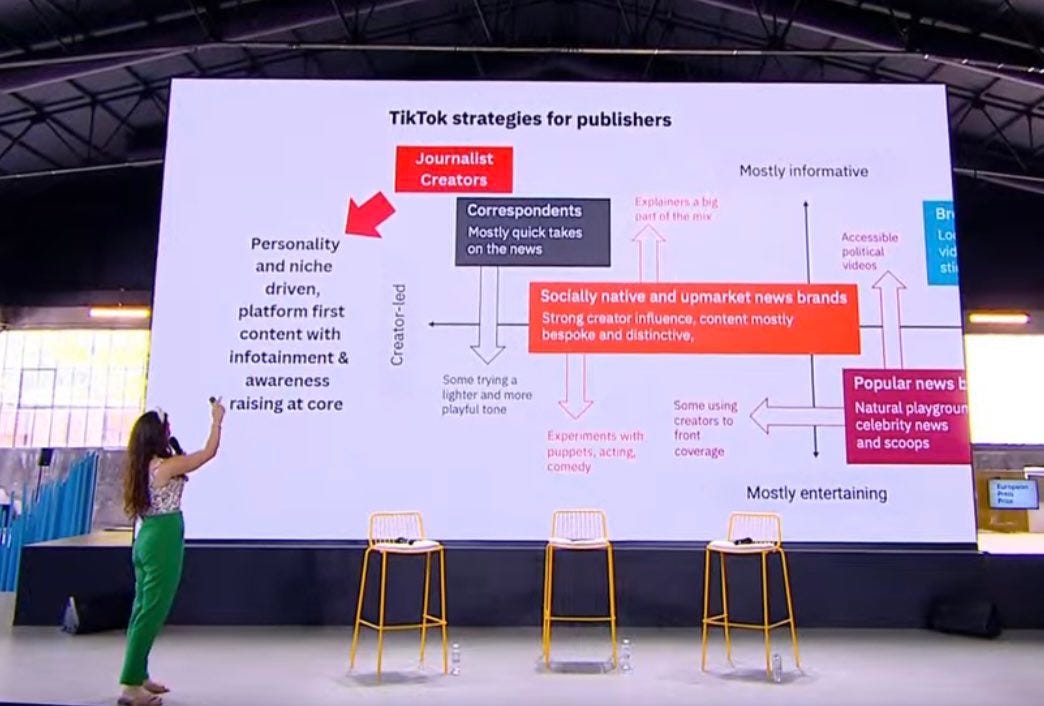Hello,
you are reading Understanding TikTok. My name is Marcus. I am currently in Philadelphia at AoIR 2023. The programme is packed with TikTok, i will be on a panel discussing Networked Soundscapes of Memetic Warfare on Saturday. And now use this hyperlink to press play: Disorder by Joy Division.
Today:
🎆 Disorder, Disinfo, Distress – and why fact-checks will not solve the problem
📹 Tips for succeeding with journalism on TikTok
⚗️ Investigating TikTok – without API access
🎛️ More – Deepfake Audio, TikTok Live, and Incels
🎆 Disorder, Disinfo, Distress – and why fact-checks will not solve the problem
Since October 7 when Hamas launched an unprecedented multi-faceted and sustained assault on Israel from the Gaza Strip, TikTok (as other platforms) has been flooded (yet again) with an endless stream of misleading content about the evolving Israel-Hamas war 2023.
The war has spawned so much false or misleading information online that it has obscured what is actually happening on the ground (New York Times). Scrolling through the endless feeds of the hashtags #palestine (36.2B views) and #israel (32.3B views) is a first hand experience of a polluted media landscape and information disorder:
Decontextualized modified audiovisual content taken from various sources (e.g. a pool of fake blood), highly emotionalized sounds and imagery (e.g. children in cages), subtle and very obvious propaganda attempts, debunking videos and supposedly debunking videos and videos debunking the debunking videos. Yet again users and bad actors have been applying platform tools like TikTok’s promote function (How a new TikTok feature is being used to spread fake news about Israel, Palestine for just $7) or effects (free palestine effect) and platform techniques (remixing of sounds) to increase reach.
The platform – as in prior conflicts – has reacted with a bunch of promises: We will continue to adapt our safeguards to protect our community (TikTok). This time after having been warned by EU officials calling for CEO Shou Zi Chew to respond within 24 hours (Politico).
If TikTok’s promises are sufficient and effective in order to prevent the spread of mis- and disinformation can be doubted. The same holds true for well-meaning attempts to contain information disorder by journalistic fact-checks in a fundamentally and irreversible altered information landscape. Or as Kyle Chayka puts it: Our feeds continue to create a feeling of transparency and granularity, while providing fewer of the signposts that we need to chart a clear path through the thicket of content (New Yorker).
⚗️ Investigating TikTok – without API access
In #109 i gave a short introduction to TikTok’s Research API. Fellow independent TikTok researchers at Stiftung Neue Verantwortung, a Berlin-based, non-profit think tank, have had a closer look at it now and they are not convinced: 🤦♀️The Research API falls woefully short.

The amount and variety of the information we have collected is incomparable to what is available through the Research API, the researchers write. They have been scraping TikTok content from the Android app. An “invaluable” approach as “smartphone apps are the most natural way to use the platform — providing data closer to what users actually encounter.”
While i would underline this take, an entire day of learning at an AoIR preconference session called Meme Analysis with Tiktok Metadata organized and run by Lucia Bainotti-University of Amsterdam, Elena Pilipets-University of Siegen, and Marloes Geboers-University of Amsterdam has showed me ways of investigating the platform via web access with a set of easy and applicable tools like Zeeschuimer (Peeters 2022), 4CAT Capture and Analysis Toolkit (Peeters & Hagen 2022), Video Frame and Audio Extractor, Speech-To-Text Converter (both Chao 2022), and ImageJ (Rasband et al. 2018).
The data scope might be limited compared to other ways, but depending on your research question, it seems to be sufficient to unwrap various aspects of TikTok’s large landscape of ever changing trends, techniques, specifics, and niches.
📹 Tips for succeeding with journalism on TikTok
We’ve reached “peak news explainer” on TikTok, Sophia Smith Galer said at the IMEDD International Journalism Forum in Athens, Greece. To break through on the platform, news outlets and journalists can’t rely exclusively on explainers and reworking existing articles (Nieman Lab).

What’s missing from the TikTok news landscape and that journalists can lean into is “personality and niche driven, platform-first content with infotainment and awareness at its core,” Smith Galer said. There you have it. If you are a journalist and you have a TikTok account doing exactly that, please let me now. Thx. And if you want to check out what other journalists and media companies are doing on TikTok i recommend TikTok Journalism with a huge data base.
🎛️ More – Deepfake Audio, TikTok Live, and Incels
💊 NewsGuard identified 17 accounts on TikTok that use AI text-to-speech software to generate videos that advance misinformation, and have garnered more than 336 million views and 14.5 million likes. (Washington Post, New York Times)
💊 I’m longing for someone to write something thoughtful about TikTok LIVE, writes Molly Soda. Yes, please!
💊 Why Countries Are Trying to Ban TikTok (New York Times)
💊 TikTok To Tailor Content Moderation To Meet African Countries’ Expectations (The Messenger)
💊 A Comparative Analysis of the Prevalence and Sources of Disinformation across Major Social Media Platforms in Poland, Slovakia, and Spain (including TikTok numbers) (TrustLab)
💊 Mainstreaming the Blackpill: Understanding the Incel Community on TikTok (Springer Link)
💊 How are early stage startups finding users on TikTok? (Olivia Moore)
💊 Expect TikTok to pop up on various screens (TikTok)
💊 Strategien im Umgang mit Antisemitismus und Hassrede auf TikTok (eBook)
Thanks for reading. Please recommend this newsletter to a person you like. Ciao.




